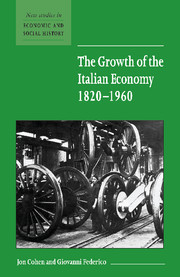Book contents
- Frontmatter
- Contents
- List of figures
- List of tables
- Acknowledgements
- 1 Introduction
- 2 Measuring change in the long run: the data
- 3 The big picture: models of growth and structural change
- 4 Modernization versus tradition: new views and old on agriculture
- 5 Against all odds? The growth of industry and services
- 6 Macroeconomic policy, institutions, and the balance of payments
- 7 An economic miracle? Italy in the Golden Age, 1945–1960
- 8 Conclusion
- Bibliography
- Index
- New Studies in Economic and Social History
- Previously published as Studies in Economic and Social History
- Economic History Society
4 - Modernization versus tradition: new views and old on agriculture
Published online by Cambridge University Press: 05 June 2012
- Frontmatter
- Contents
- List of figures
- List of tables
- Acknowledgements
- 1 Introduction
- 2 Measuring change in the long run: the data
- 3 The big picture: models of growth and structural change
- 4 Modernization versus tradition: new views and old on agriculture
- 5 Against all odds? The growth of industry and services
- 6 Macroeconomic policy, institutions, and the balance of payments
- 7 An economic miracle? Italy in the Golden Age, 1945–1960
- 8 Conclusion
- Bibliography
- Index
- New Studies in Economic and Social History
- Previously published as Studies in Economic and Social History
- Economic History Society
Summary
4.1 Stefano Jacini, chairman of the commission that produced the great survey of Italian agriculture in the 1880s, observed in his introduction that ‘we still find many different agricultural Italies’ (Jacini 1882–6). This simple, frequently quoted observation has provided justification for agricultural historians in Italy to focus on small areas (a region or a province) instead of the country as a whole and to stress differences in environment, crop mix, techniques and institutions more than similarities. While often rich in local details, this approach poses a challenge for the reviewer concerned as much with the forest as with individual trees. The research fails to adhere to a single format, to ask standard questions and thus to provide comparable kinds of answers. The studies are difficult to review as a group and almost impossible to use as a source for national trends in productivity, crop yields and overall output. We draw on them where appropriate but rely for the most part on the few studies that do attempt to deal with Italian agriculture as a whole.
Until recently, it was generally accepted – Romeo (1963) was a conspicuous dissenter from this consensus – that Italian agriculture was technologically backward and subsistence-oriented. As Renato Zangheri, a well-known agricultural historian, observed (1969, p. 53): ‘[Italian] agriculture has never sustained a regular and general development.’ Most scholars argued that landlords were largely (but not exclusively) to blame for agriculture's unimpressive performance.
- Type
- Chapter
- Information
- The Growth of the Italian Economy, 1820–1960 , pp. 30 - 45Publisher: Cambridge University PressPrint publication year: 2001



